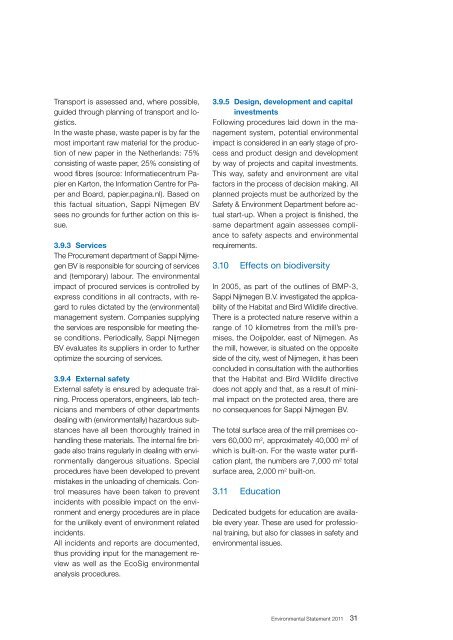2011 Environmental Statement 1.8 MB - Sappi
2011 Environmental Statement 1.8 MB - Sappi
2011 Environmental Statement 1.8 MB - Sappi
Create successful ePaper yourself
Turn your PDF publications into a flip-book with our unique Google optimized e-Paper software.
Transport is assessed and, where possible,<br />
guided through planning of transport and logistics.<br />
In the waste phase, waste paper is by far the<br />
most important raw material for the production<br />
of new paper in the Netherlands: 75%<br />
consisting of waste paper, 25% consisting of<br />
wood fibres (source: Informatiecentrum Papier<br />
en Karton, the Information Centre for Paper<br />
and Board, papier.pagina.nl). Based on<br />
this factual situation, <strong>Sappi</strong> Nijmegen BV<br />
sees no grounds for further action on this issue.<br />
3.9.3 Services<br />
The Procurement department of <strong>Sappi</strong> Nijmegen<br />
BV is responsible for sourcing of services<br />
and (temporary) labour. The environmental<br />
impact of procured services is controlled by<br />
express conditions in all contracts, with regard<br />
to rules dictated by the (environmental)<br />
management system. Companies supplying<br />
the services are responsible for meeting these<br />
conditions. Periodically, <strong>Sappi</strong> Nijmegen<br />
BV evaluates its suppliers in order to further<br />
optimize the sourcing of services.<br />
3.9.4 External safety<br />
External safety is ensured by adequate training.<br />
Process operators, engineers, lab technicians<br />
and members of other departments<br />
dealing with (environmentally) hazardous substances<br />
have all been thoroughly trained in<br />
handling these materials. The internal fire brigade<br />
also trains regularly in dealing with environmentally<br />
dangerous situations. Special<br />
procedures have been developed to prevent<br />
mistakes in the unloading of chemicals. Control<br />
measures have been taken to prevent<br />
incidents with possible impact on the environment<br />
and energy procedures are in place<br />
for the unlikely event of environment related<br />
incidents.<br />
All incidents and reports are documented,<br />
thus providing input for the management review<br />
as well as the EcoSig environmental<br />
analysis procedures.<br />
3.9.5 Design, development and capital<br />
investments<br />
Following procedures laid down in the management<br />
system, potential environmental<br />
impact is considered in an early stage of process<br />
and product design and development<br />
by way of projects and capital investments.<br />
This way, safety and environment are vital<br />
factors in the process of decision making. All<br />
planned projects must be authorized by the<br />
Safety & Environment Department before actual<br />
start-up. When a project is finished, the<br />
same department again assesses compliance<br />
to safety aspects and environmental<br />
requirements.<br />
3.10 Effects on biodiversity<br />
In 2005, as part of the outlines of BMP-3,<br />
<strong>Sappi</strong> Nijmegen B.V. investigated the applicability<br />
of the Habitat and Bird Wildlife directive.<br />
There is a protected nature reserve within a<br />
range of 10 kilometres from the mill’s premises,<br />
the Ooijpolder, east of Nijmegen. As<br />
the mill, however, is situated on the opposite<br />
side of the city, west of Nijmegen, it has been<br />
concluded in consultation with the authorities<br />
that the Habitat and Bird Wildlife directive<br />
does not apply and that, as a result of minimal<br />
impact on the protected area, there are<br />
no consequences for <strong>Sappi</strong> Nijmegen BV.<br />
The total surface area of the mill premises covers<br />
60,000 m 2 , approximately 40,000 m 2 of<br />
which is built-on. For the waste water purification<br />
plant, the numbers are 7,000 m 2 total<br />
surface area, 2,000 m 2 built-on.<br />
3.11 Education<br />
Dedicated budgets for education are available<br />
every year. These are used for professional<br />
training, but also for classes in safety and<br />
environmental issues.<br />
<strong>Environmental</strong> <strong>Statement</strong> <strong>2011</strong> 31

















